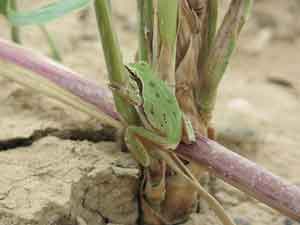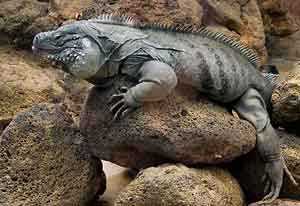Success of amphibian social networking spawns Reptile BioBlitz
Photos and observations posted to the website of the Global Amphibian BioBlitz now cover more than 700 species: 10 percent of the world's frog, toad and salamander species that the social networking effort hopes to track. This success has now spawned a Reptile BioBlitz.
September 7, 2011
An army sergeant in Iraq posted to Facebook a photo of a Lemon-yellow Tree Frog he encountered in a latrine, while a student participating in a scientific expedition in Costa Rica snagged a photo of a toad biologists had thought extinct. A biologist and writer contributed a photo of an endangered frog he’d found 30 miles outside its isolated, mountain-top range in Venezuela.

"Jonathan" posted this photo on May 26, 2011, with the note: "Tree frog found in a latrine on Joint Base Balad near Al Bakr, Iraq. Frog released in nearby retention pond. "
These are some of the successes of the three-month-old Global Amphibian BioBlitz, which is harnessing the power of social media – Facebook, Flickr and other sites – to track threatened species around the globe. More than 190 threatened frog, toad and salamander species from 55 countries have so far been logged via the website iNaturalist.org, with two amateurs each posting more than 100 photos of distinct amphibian species.
This success has now spawned a Global Reptile BioBlitz to take advantage of the even greater public interest in lizards and snakes.
“What’s most exciting is seeing complete non-professionals – amateur but enthusiastic amphibian people – getting involved, which is the kind of interest I want to see,” said herpetologist Michelle Koo, a University of California, Berkeley, research scientist who is one of the coordinators of BioBlitz and helps manage AmphibiaWeb, an Internet database hosted by the campus’s Museum of Vertebrate Zoology. “I think it’s great to now tap into the larger group of reptile people.”
The Global Reptile BioBlitz, launched last week during Global Assessment for Reptile Distribution meeting in Tel Aviv, Israel, will track the world’s 9,500 reptiles. Both the amphibian and reptile BioBlitz efforts are a partnership between international herpetology organizations, including AmphibiaWeb, and the social network iNaturalist.org.
According to Scott Loarie, a researcher at the Carnegie Institution for Science and a coordinator of BioBlitz, amphibian and reptile populations are declining rapidly around the globe because of disease, climate change, habitat loss and irresponsible collecting. The first step towards conserving reptiles and amphibians is to gather data where populations persist, and social networking can help.
“From the volume of photos shared on the Internet, it’s clear that there is a critical mass of people passionate about all sorts of creatures,” Loarie said. “They are just beginning to mobilize for science and conservation.”

The critically endangered Grand Cayman Iguana (Cyclura nubila lewisi). Photo by Brian Gratwicke.
BioBlitz hopes to collect photos shared on social networks like Flickr and Facebook and use the geo-referenced and scientifically verified sightings to assess the health of populations of the world’s 7,000 amphibian species. The Global Amphibian BioBlitz has already collected over 700 distinct species – more than 10 percent of the world’s amphibians – from thousands of observations contributed by hundreds of participants.
The scientifically vetted contributions will be searchable through a new cloud-based assembly called VertNet.
“These kinds of vetted observations can be extremely valuable, as much as museum records in helping us predict and understand species distributions,” said Carol Spencer, a staff curator at the Museum of Vertebrate Zoology who is co-principal investigator on HerpNET and VertNet.
“Efforts like the BioBlitz that connect amateur photographers and nature enthusiasts with scientists are great because not only do they generate data, but they’re also powerful education tools,” says Gary Sharlow, manager of lifelong learning at the California Academy of Sciences, one of the groups partnering on the Global Reptile BioBlitz, and leader of the academy’s conservation photography workshop series. “When you understand an animal’s role in its ecosystem, a photograph of that animal can become much more than a pretty picture – it can change your perspective, and even support conservation efforts.”
For more information:
- Storing vertebrates in the cloud (Aug. 23, 2011 press release about VertNet)
- Can social networking save the world’s amphibians? (May 25, 2011 press release)